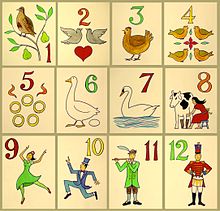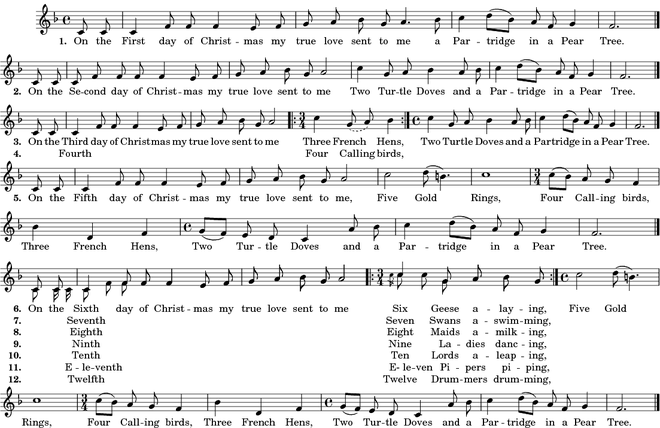 The 12 Days of Christmas
The 12 Days of Christmas 

The 12 Days of Christmas are now most famous as a song about someone receiving lots of presents from their 'true love'. However, to get to the song there had to be the days to start with!
The 12 Days of Christmas start on Christmas Day and last until the evening of the 5th January - also known as Twelfth Night. The 12 Days have been celebrated in Europe since before the middle ages and were a time of celebration.
The 12 Days each traditionally celebrate a feast day for a saint and/or have different celebrations:
- Day 1 (25th December): Christmas Day - celebrating the Birth of Jesus
- Day 2 (26th December also known as Boxing Day): St Stephen’s Day. He was the first Christian martyr (someone who dies for their faith). It's also the day when the Christmas Carol 'Good King Wenceslas' takes place.
- Day 3 (27th December): St John the Apostle (One of Jesus's Disciples and friends)
- Day 4 (28th December): The Feast of the Holy Innocents - when people remember the baby boys which King Herod killed when he was trying to find and kill the Baby Jesus.
- Day 5 (29th December): St Thomas Becket. He was Archbishop of Canterbury in the 12th century and was murdered on 29th December 1170 for challenging the King’s authority over Church.
- Day 6 (30th December): St Egwin of Worcester.
- Day 7 (31st December): New Years Eve (known as Hogmanay in Scotland). Pope Sylvester I is traditionally celebrated on this day. He was one of the earliest popes (in the 4th Century). In many central and eastern European countries (including Austria, Bosnia and Herzegovina, Croatia, the Czech Republic, Germany, Hungary, Israel, Italy, Luxembourg, Poland, Slovakia, Switzerland and Slovenia) New Years Eve is still sometimes called 'Silvester'. In the UK, New Years Eve was a traditional day for ‘games’ and sporting competitions. Archery was a very popular sport and during the middle ages it was the law that it had to be practised by all men between ages 17-60 on Sunday after Church! This was so the King had lots of very good archers ready in case he need to go to war!
- Day 8 (1st January): 1st January - Mary, the Mother of Jesus
- Day 9 (2nd January): St. Basil the Great and St. Gregory Nazianzen, two important 4th century Christians.
- Day 10 (3rd January): Feast of the Holy Name of Jesus. This remembers when Jesus was officially 'named' in the Jewish Temple. It's celebrated by different churches on a wide number of different dates!
- Day 11 (4th January): St. Elizabeth Ann Seton, the first American saint, who lived in the 18th and 19th centuries. In the past it also celebrated the feast of Saint Simon Stylites (who lives on a small platform on the top of a pillar for 37 years!).
- Day 12 (5th January also known as Epiphany Eve): St. John Neumann who was the first Bishop in American. He lived in the 19th century.
Twelfth Night
Twelfth Night was a big time of celebration with people holding large parties. During these parties, often the roles in society were reversed with the servants being served by the rich people. This dated back to medieval and Tudor times when Twelfth Night marked the end of 'winter' which had started on 31st October with All Hallows Eve (Halloween).
At the start of Twelfth Night the Twelfth Night cake was eaten. This was a rich cake made with eggs and butter, fruit, nuts and spices. The modern Italian Panettone is the cake we currently have that's most like the old Twelfth Night cake.
A dried pea or bean was cooked in the cake. Whoever found it was the Lord (or Lady) of Misrule for night. The Lord of Misrule led the celebrations and was dressed like a King (or Queen). This tradition goes back to the Roman celebrations of Saturnalia. In later times, from about the Georgian period onwards, to make the Twelfth Night 'gentile', two tokens were put in the cake (one for a man and one for a women) and whoever found them became the the 'King' and 'Queen' of the Twelfth Night party.
In English Cathedrals during the middle ages there was the custom of the 'Boy Bishop' where a boy from the Cathedral or monastery school was elected as a Bishop on 6th December (St Nicholas Day) and had the authority of a Bishop (except to perform Mass) until 28th December. King Henry VIII banned the practise in 1542 although it came back briefly under Mary I in 1552 but Elizabeth I finally stopped it during her reign.
The first monday after Christmas feast has finished was known as ‘Plough Monday’ as this was when farming work would all begin again!During Twelfth Night it was traditional for different types of pipes to be played, especially bagpipes. Lots of games were played including ones with eggs. These included tossing an egg between two people moving further apart during each throw - drop it and you lose and passing an egg around on spoons. Another popular game was 'snapdragon' where you picked raisins or other dried fruit out of a tray of flaming brandy!
In many parts of the UK, people also went Wassailing on Twelfth Night.
Twelfth Night is also known as Epiphany Eve. In many countries it's traditional to put the figures of the Wise Men/Three Kings into the Nativity Scene on Epiphany Eve ready to celebrate Epiphany on the 6th January.
It's also traditional to take your Christmas decorations down following Twelfth Night.
Twelfth Night is also the name of a famous play written by William Shakespeare. It's thought it was written in 1601/1602 and was first performed at Candlemas in 1602, although it wasn't published until 1623.














